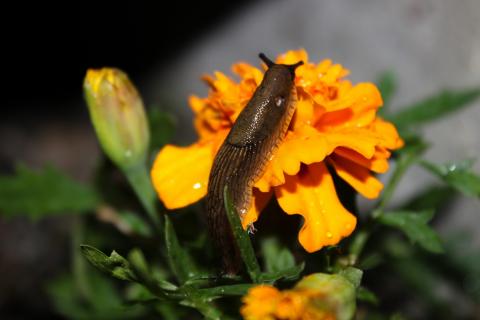What can I do to control the slugs in my garden?

Slugs can represent a huge challenge for many gardeners. They attack a wide variety of herbaceous plants including annuals, perennials, and vegetable crops. Slugs are actually terrestrial mollusks and are related to oysters, clams, and mussels. Because they don’t have a shell, slugs are at risk of drying out. As a result, they are almost always found in locations that are humid or wet, and do most of their feeding at night when they can avoid the sun’s rays and the humidity is higher. During the day, they hide out at the base of plants or in garden mulch.
Slug damage looks much like the feeding of caterpillars or other insect pests, but with one distinct difference. As slugs move and feed, they leave behind a noticeable mucus trail which hardens and appears shiny during the day. Slugs have a rasping mouthpart that they use to chew holes in the leaves and flowers of plants.
To reduce the slug population in your garden, you need to start by changing the environment in the garden. Remove all slug hiding places such as old plant debris, mulch, stones, or logs - basically anywhere a slug may be drawn to hide during the day. Next, make sure plants are spaced adequately and prune them to encourage good air circulation. Do not apply irrigation late in the day or in the evening to give the soil a chance to dry out. Dry soil is much less attractive slug habitat.
If you’ve changed the habitat in your garden and still have issues, the next step is to set traps for them. Place boards or damp paper towel rolls on the ground in the evening. When morning comes, the slugs will use these places to hide, at which time you can kill them. Many gardeners also have luck placing beer in shallow plastic containers which attracts slugs and subsequently drowns them. If you must handle slugs, it’s always a good idea to wear gloves. Slugs harbor many parasites that have the potential to make people sick.
Diatomaceous earth can be spread around the base of vulnerable plants. Diatomaceous earth keeps the slugs away by cutting the outside of their bodies and thus causing them to dehydrate. It works best under dry conditions and must be reapplied after every rain event or irrigation session.
You can also purchase chemical slug baits that attract slugs and kill them by poisoning. Using pesticides alone is rarely enough to measurably reduce slug populations. However, pesticides used in concert with cultural changes in the garden can make a big difference. If using any pesticide product, remember to read and follow the instructions on the product label.
Got questions? The Ask UNH Extension Infoline offers practical help finding answers for your home, yard, and garden questions. Call toll free at 1-877-398-4769, Monday to Friday, 9 a.m. to 2 p.m., or e-mail us at answers@unh.edu.
Do you love learning about stuff like this?
SUBSCRIBE TO Granite State Gardening newsletter
Got questions? The UNH Extension Yard and Garden Infoline offers practical help finding answers for your yard and garden questions.
Call toll free at 1-877-398-4769, Monday to Friday, 9 a.m. to 2 p.m., or fill out webform.
